Mui Ne, a charming coastal town in Vietnam, captivates visitors not only with its stunning landscapes and picturesque beaches but also with its vibrant culinary scene. Renowned for its seafood specialties, the town offers an array of local dishes that reflect the rich flavors of the ocean and the agricultural bounty of the region. The essence of Mui Ne's cuisine lies in its fresh ingredients, traditional cooking techniques, and the cultural significance of communal dining. From interactive hotpot experiences to flavorful seafood salads, the local dishes in Mui Ne tell stories of the people, their traditions, and their deep connection to the sea. This article will explore the must-try seafood specialties, unique traditional dishes, popular street food options, and the signature ingredients that define Mui Ne’s culinary identity.
When it comes to Muine's culinary offerings, seafood takes center stage. The diversity of the ocean results in a remarkable range of dishes that capture the essence of marine bounty. Seafood here is not just food; it's a rich cultural experience infused with communal joy and vibrant flavors. Imagine biting into freshly grilled squid, its smoky aroma intermingling with hints of garlic and herbs, or savoring the delicate sweetness of spanner crab, a true royal delight. Each seafood dish in Mui Ne tells its own story, rooted deeply in the local fishing traditions and marked by the freshness of the ingredients used.
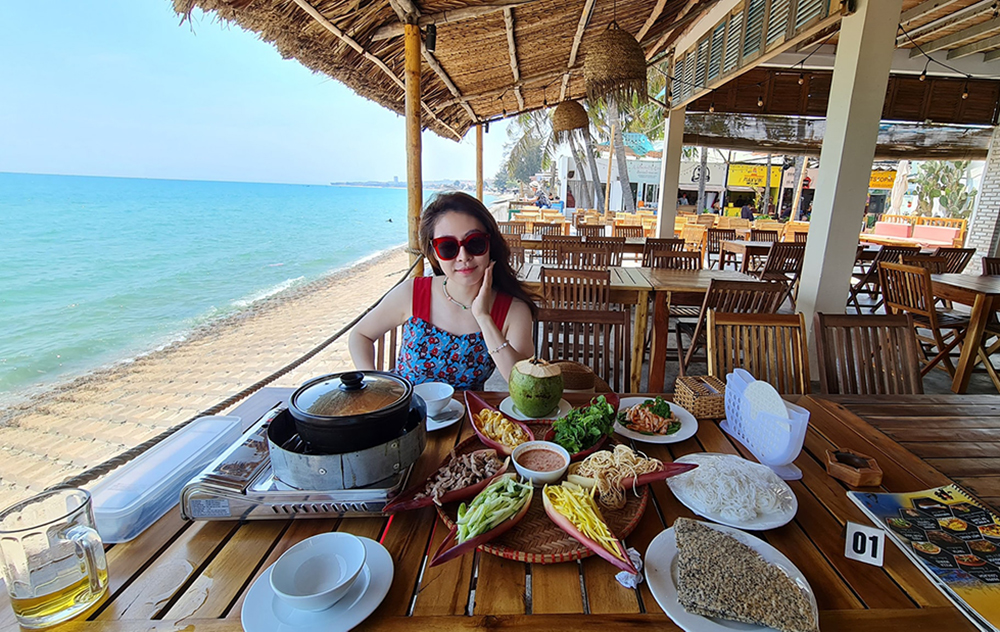
In order to better appreciate the flavors of Mui Ne, it is essential to recognize the role of communal dining, which brings together friends and family. Seafood specialties, such as Tha Hotpot and spanner crab, highlight this vibrant dining culture. These dishes often embody the Vietnamese philosophy of harmony and balance, emphasizing fresh ingredients that complement each other in both taste and appearance. The use of local herbs and spices elevates these dishes, ensuring that the fresh bounty of the ocean is celebrated during each meal.
To provide a clearer overview, here’s a comparison table of some must-try seafood specialties alongside their key features:
| Dish Name | Main Ingredients | Cooking Method | Flavor Profile |
|---|---|---|---|
| Tha Hotpot | Fresh fish, shellfish, vegetables | Boiling at the table | Savory, aromatic, with rich broth |
| Spanner Crab | Spanner crab, garlic, herbs | Grilled or steamed | Sweet, tender with a touch of smokiness |
| Grilled Seafood | Squid, prawns, local fish | Grilled over charcoal | Smoky, spicy, fresh |
These dishes serve as a gateway for culinary exploration in Muine and encapsulate the heart of local dining culture.
Tha Hotpot, or Lẩu Thả, serves as a quintessential dish reflecting the local flavors of Mui Ne. Unlike typical hotpots found elsewhere, Tha Hotpot denotes a communal experience where diners immerse themselves in a flavorful broth, dipping various fresh ingredients to cook right on the table. The name "Tha" translates to "drop," a fitting description for this interactive dining style that invites both participation and enjoyment.
Ingredients and Preparation: Tha Hotpot showcases an impressive array of local seafood, including fish, shrimp, squid, and shellfish, paired with a colorful medley of vegetables, herbs, and noodles. What sets this hotpot apart is its rich and aromatic broth, often simmered for hours with spices and seasonings to ensure a complex flavor profile. Diners are encouraged to customize their pot, allowing everyone to curate a personal dining experience. The act of cooking together symbolizes the community spirit each person adding their own unique touch to the hotpot.
As diners plunge the fresh ingredients into the bubbling broth, they become part of an age-old tradition steeped in Vietnamese culture. Tha Hotpot not only tantalizes the taste buds but also nourishes the soul. The vibrant colors and flavors of the dish mirror the stunning coastal scenery of Mui Ne, creating a feast for both the eyes and palate.
Cultural Significance: More than just a meal, Tha Hotpot represents the Vietnamese love for sharing food with family and friends. In a society where communal dining is valued, gathering around the hotpot reinforces unity and bonds. It encapsulates the philosophy of enjoying the present moment, where conversation flows as freely as the delicious broth simmering on the table. Dining becomes an experience filled with laughter, stories, and memories all centered around the joy of food.
Where to Try Tha Hotpot: Visitors can immerse themselves in this quintessential dining experience at various restaurants throughout Mui Ne. Notable spots include:
Tha Hotpot embodies the essence of not just a meal but a celebration of life the flavors, the togetherness, and the unforgettable moments shared at the table.
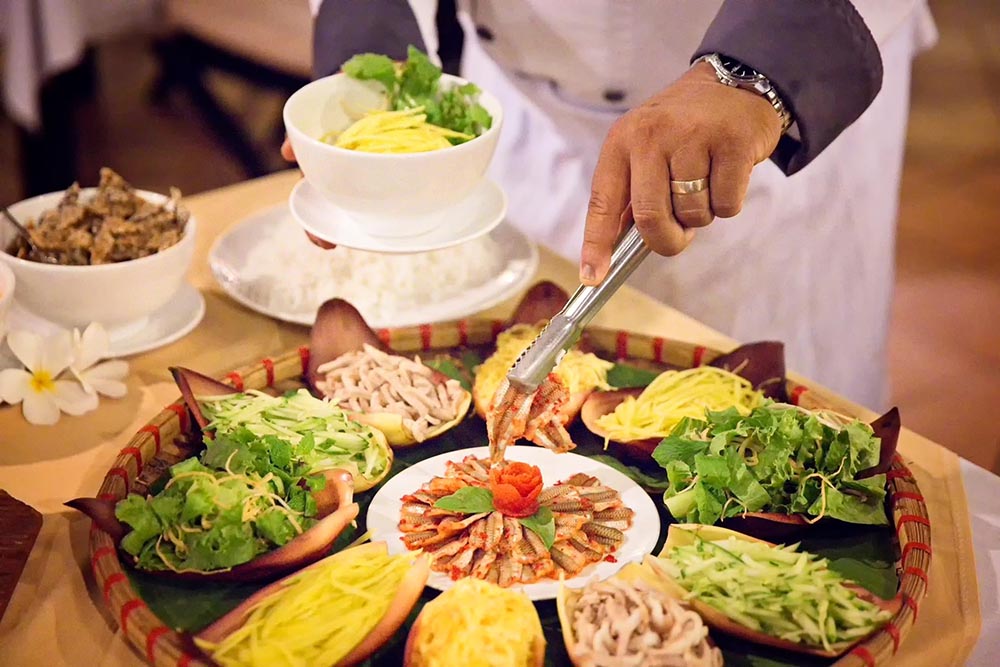
Spanner crab, known locally as Huỳnh Đế crab, is frequently referred to as the "royalty" of local seafood dishes. Hailing from coastal regions like Mui Ne, this crab variety is famous for its sweet, tender meat and is a sought-after delicacy in Vietnamese cuisine. The seasonal nature of spanner crab lends an air of exclusivity to its consumption, making it a dish that many anticipate throughout the year.
In preparation, spanner crabs can be enjoyed in a myriad of ways. From steaming the crab to retain its delicate flavor to impassioned grilling that complements the meat's inherent sweetness, each method highlights the crab's finesse as a key ingredient. When marinating the crabs for grilling, ingredients like lime juice, garlic, and chili are commonly used to amplify natural flavors, resulting in a dish with a deeply satisfying taste profile.
One remarkable aspect of spanner crab is its robustness in terms of nutritional value. This seafood is rich in omega-3 fatty acids known for their heart-health benefits and offers about 15.1 grams of protein per serving. Therefore, indulging in spanner crab is not just a treat for the taste buds but a healthy choice as well.
Savoring spanner crab while overlooking the pristine beach is an experience that epitomizes the essence of Mui Ne’s culinary charm. The satisfying crunch of the grilled crab shell, together with the succulent meat that bursts with flavor, creates an unforgettable moment for diners. Accompanying sauces made from chili, lime, and garlic further enhance the experience, allowing diners to tailor each bite to their preferences.
To truly appreciate the luxury of spanner crab, travelers must seek out the crowded beachside grills where freshly caught crabs are prepared daily. Each crab showcases the brilliant culinary craftsmanship of the local vendors, making every visit a memorable adventure for seafood lovers.
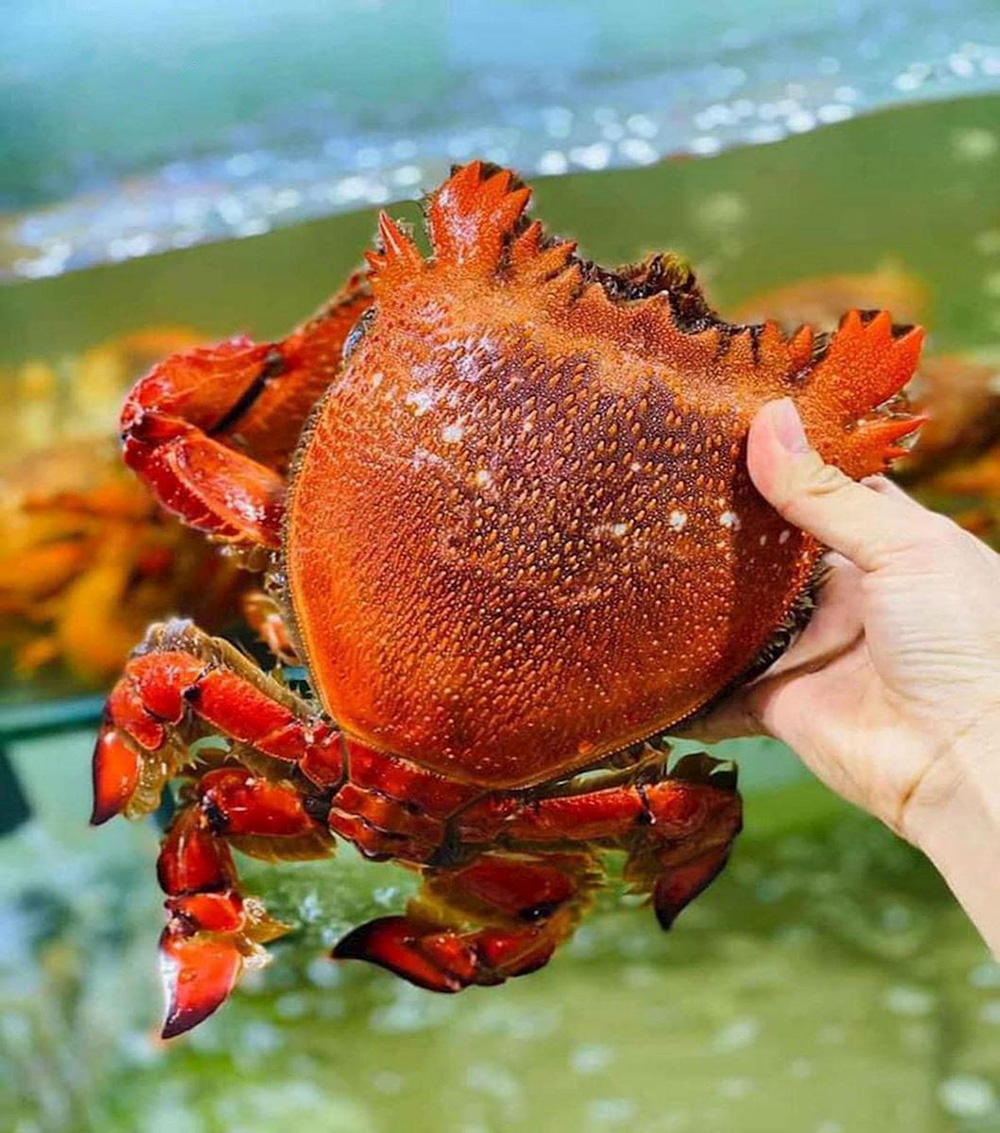
For those visiting Mui Ne, no culinary experience is complete without indulging in grilled seafood a signature representation of the coastal town's vibrant street food culture. In Muine's market stalls and beachfront restaurants, the enticing aroma of grilling seafood wafts through the air, beckoning passersby to indulge in this delectable feast.
Grilled seafood in Mui Ne encompasses a variety of options from shrimp, squid, and fish to clams and octopus. As the seafood is grilled over hot charcoal, the flames imbue each dish with a rich, smoky flavor that beautifully complements the inherent sweetness of the ocean-fresh ingredients. Seasoning these grilled delicacies often involves a mix of garlic, salt, and local herbs, ensuring that each bite is packed with depth and character.
A unique feature of grilled seafood dining in Mui Ne is the custom of portioning the food onto banana leaves or wooden skewers. This traditional serving style not only enhances the presentation but also adds an extra element of nostalgia, evoking images of family gatherings around warm fires. Diners are often served with a variety of dipping sauces, including spicy chili sauce, tangy tamarind, and fragrant fish sauce that further elevates the experience.
Here’s a comparison of some popular grilled seafood options available in Mui Ne:
| Seafood Item | Cooking Method | Flavor Profile | Common Accompaniments |
|---|---|---|---|
| Grilled Prawns | Grilled over charcoal | Sweet, smoky, slightly spicy | Nuoc Cham (fish sauce), lime |
| Grilled Squid | Charcoal grilled | Tender, smoky, with a subtle char | Chili sauce, garlic dip |
| Grilled Fish | Open flame grilled | Savory, with crispy skin | Fresh herbs, fruits, sauces |
Beyond the taste, the communal aspect of sharing grilled seafood with friends and family enhances the overall dining experience, embodying the spirit of togetherness. From grabbing a skewer of delicious grilled squid to rolling up a fresh spring roll complemented by local herbs and sauce, every meal becomes a celebration of flavor that leaves a lasting impression.
Taking the time to indulge in the local grilled seafood not only satisfies the palate but also acts as a reminder of the unmistakable bond between culture, food, and community that defines Mui Ne.
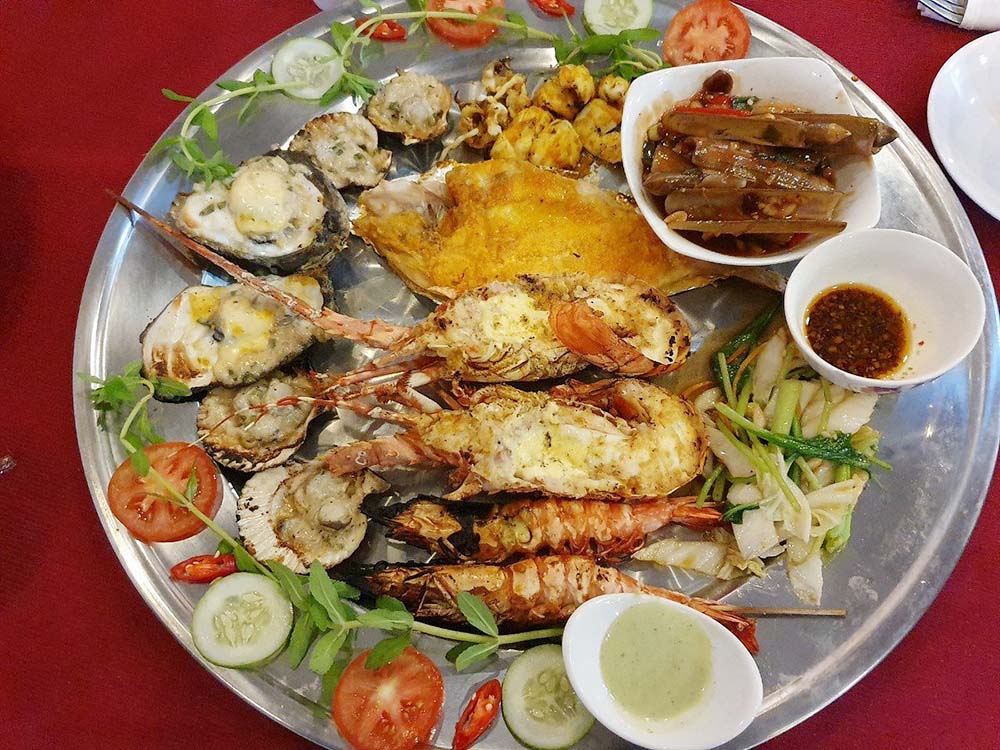
As diverse as the seafood offerings are in Mui Ne, there are also unique traditional dishes that speak to the region's culinary heritage, showcasing the abundance of fresh ingredients. Each dish tells a historical narrative, often rooted in traditional family recipes passed down through generations. The creativity present in Mui Ne's culinary landscape showcases local ingredients prepared in ways that honor their natural flavors while incorporating elements of modern cooking techniques. These traditional dishes are essential once you traverse the food scene in Mui Ne, providing visitors with a chance to experience tested culinary artistry from the local culture.
Among the unique traditional dishes of Mui Ne, Mai Fish Salad, known as Gỏi Cá Mai, stands out as a refreshing delight. This dish is a vibrant combination of flavors, incorporating the delicate meat of fresh Mai fish, commonly found in coastal waters, with a symphony of herbs and vegetables. Mai fish is prized for its tender white flesh, making it an ideal base for this salad.
To prepare Mai Fish Salad, the fish is filleted and immersed in iced water to firm its texture before being combined with a colorful array of ingredients: thinly sliced fresh vegetables, zesty herbs, and vibrant garnishes such as roasted peanuts or fried shallots. The dressing, typically made with a zesty fish sauce and lime combination, adds a tangy element that perfectly balances the richness of the fish, elevating it to new heights.
The presentation of Mai Fish Salad is nothing short of artful, often served with crisp lettuce leaves, offering a canvas for building delicate wraps. As diners compose their bites, it becomes an engaging experience that encourages exploration of flavors and textures.
This dish exemplifies the fresh and healthy coastal cuisine of Mui Ne, making it an incredibly popular option among locals and tourists alike. Mai Fish Salad is often enjoyed during family gatherings and celebrations, highlighting its significance in the local culinary culture.
The invigorating contrast of flavors within Mai Fish Salad illustrates the region's dedication to showcasing fresh, high-quality ingredients while celebrating Vietnamese culinary traditions.
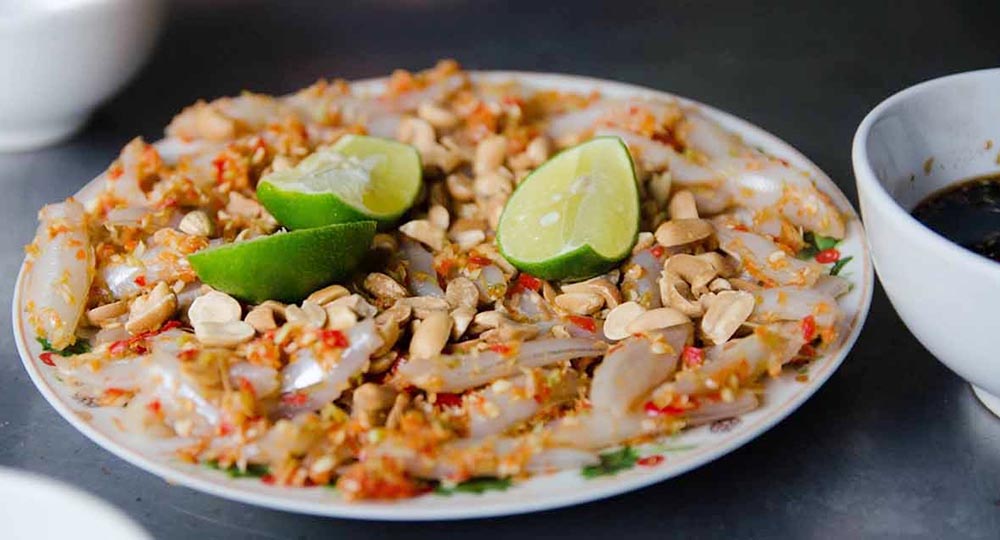
In the realm of unique local dishes, Banh Xeo holds a special place. Known as Vietnamese crispy pancakes, Banh Xeo in Mui Ne is particularly notable for its seafood variations. The batter is composed of rice flour and turmeric, which gives the pancakes their signature vibrant yellow color, enticing both the eyes and the palate.
To prepare Banh Xeo, the rice flour batter is poured into a hot skillet, where it sizzles upon contact, bringing the name “Banh Xeo” (sizzling cake) to life. The filling typically consists of a medley of local seafood, including shrimp and other fish, complemented by bean sprouts, herbs, and pieces of pork belly. This combination results in a delightful contrast of crispy outer layers and a savory filling bursting with flavors.
Once cooked to perfection, the pancake is folded over, creating a tantalizing, crispy envelope that encases the delicious filling. Banh Xeo is typically served with fresh herbs and a tangy dipping sauce known as Nuoc Cham, which combines the sweet, sour, and salty flavors characteristic of Vietnamese cuisine.
The exploration of Banh Xeo transcends mere taste; the dish transforms into an experience that invites diners to engage with their food actively. Rolling pieces of the pancake in crisp lettuce leaves, paired with fresh herbs and dipping them in sauce, allows for an immersive and joyful meal.
Banh Xeo speaks to the heart of Vietnamese street food culture, where every bite encapsulates the love and artistry behind each culinary creation. Inviting flavors, crispy textures, and vibrant presentations make Banh Xeo a must-try for anyone visiting Mui Ne.
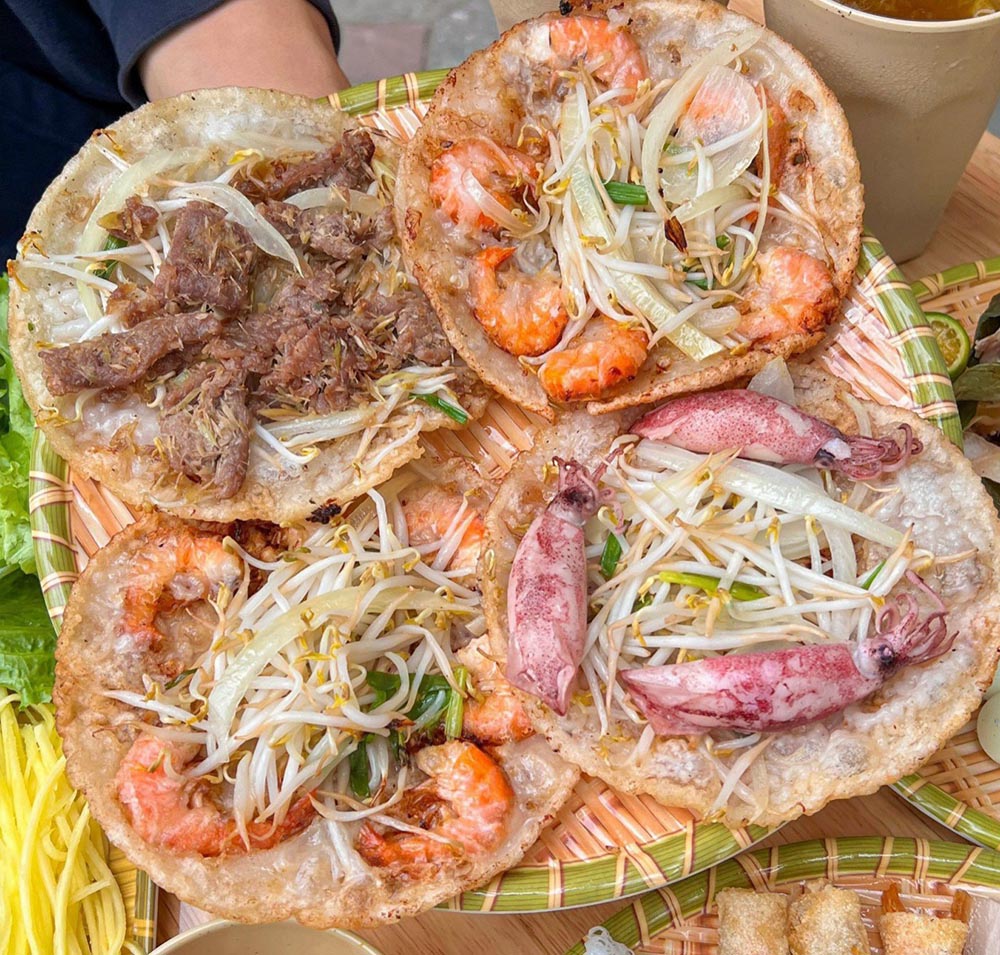
Another unique traditional dish that exemplifies the culinary culture of Mui Ne is Quai Vac Cake. Also known as dumplings, Quai Vac is a beloved local treat that highlights the use of fresh ingredients prepared with care and precision. Typically filled with minced seafood or pork, these dumplings are crafted into delicate pockets of flavor and texture.
The dough used for Quai Vac is a harmonious blend of rice flour and tapioca flour, achieving a soft and slightly chewy exterior that envelops the colorful fillings inside. Upon biting into a Quai Vac, the translucent skin is often enough to catch a glimpse of the vibrant minced filling, creating an appealing visual impact in addition to its delicious flavor.
Often served in a light broth or with a dipping sauce, Quai Vac becomes a comforting dish that reflects the warmth of Vietnamese culinary traditions. Garnished with fresh herbs and served with a light dipping sauce, this dish lends itself to a delightful eating experience perfect for both intimate gatherings and larger celebrations.
Quai Vac cakes are popular throughout Mui Ne, often enjoyed as a snack or appetizer during social meals. The craft and effort invested in creating these dumplings speak volumes about the dedication to authenticity and quality present in the region's food culture.
Through their delightful textures and robust flavors, Quai Vac Cakes exemplify the local chefs' ability to blend tradition and innovation, creating a culinary experience that honors Mui Ne's rich food heritage.
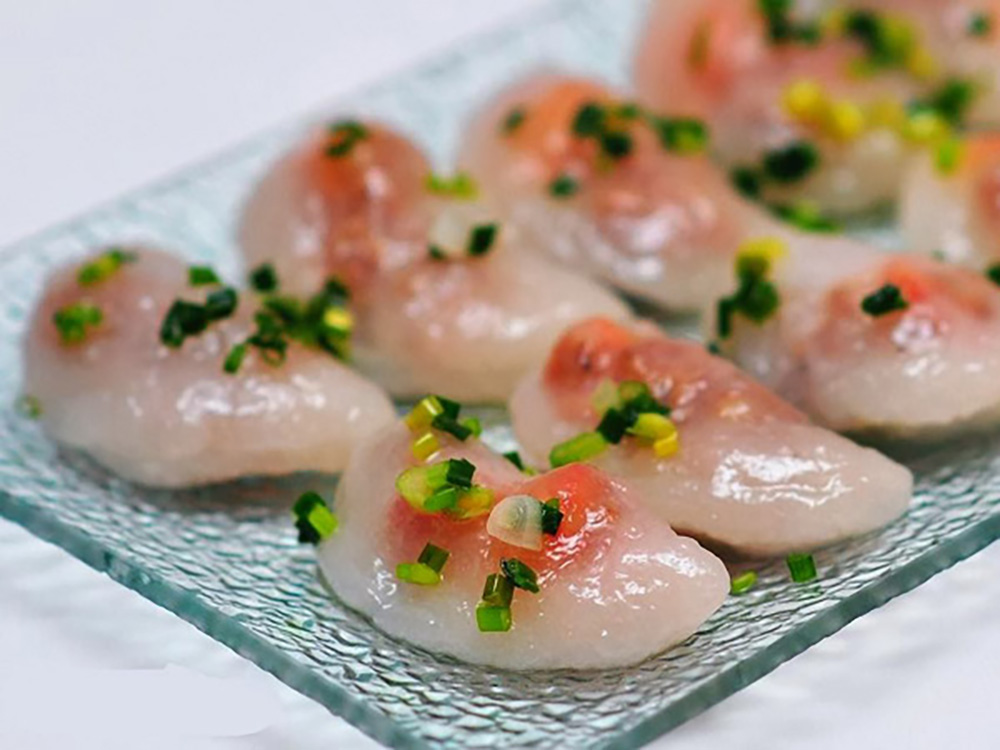
Street food in Mui Ne is a vibrant celebration of local tastes and convenience. The diverse selection of options not only caters to varied palates but also reflects the community's culinary spirit. By immersing oneself in Muine's street food culture, visitors can experience authentic flavors and cooking methods that resonate with local traditions.
One of the standouts from the vibrant street food scene is Cha Lui, a dish consisting of marinated minced pork that is skewered and grilled to perfection. The delightful aroma of these grilled delicacies wafts through the streets, luring locals and tourists alike to enjoy the succulent bites of savory goodness.
Cha Lui is prepared with tender minced pork, typically marinated with garlic, fish sauce, sugar, and a sprinkle of black pepper contributing to its robust flavor. Once skewered on bamboo sticks, the pork is grilled over charcoal, resulting in a tantalizingly crispy exterior while keeping the inside juicy and flavorful. Served alongside fresh herbs, rice paper, and a variety of dipping sauces, this dish captures the rich essence of street food culture in Mui Ne.
Grilled Cha Lui is not just food; it embodies the social aspect of Vietnamese dining. The act of assembling fresh ingredients and creating your own spring rolls enhances the dining experience and reflects the country's culinary camaraderie.
Here’s a brief overview of the popular street food options in Mui Ne:
| Street Food Dish | Main Ingredients | Cooking Method | Flavor Profile |
|---|---|---|---|
| Cha Lui | Minced pork, garlic, fish sauce | Grilled over charcoal | Savory, fragrant, slightly sweet |
| Banh Mi | Baguette, vegetables, assorted meats | Freshly made, assembled | Crisp, savory, spicy |
| Goi Cuon | Rice paper, shrimp, vegetables, rice noodles | Rolled and served fresh | Fresh, crunchy, bursting with flavor |
The allure of street food in Mui Ne lies in its ability to unite flavors, cultures, and people all within the bustling markets and lively streets. Discovering the intricate balance of flavors and textures allows food lovers to create lifelong memories; each dish symbolizes a unique connection to the vibrant local culture.
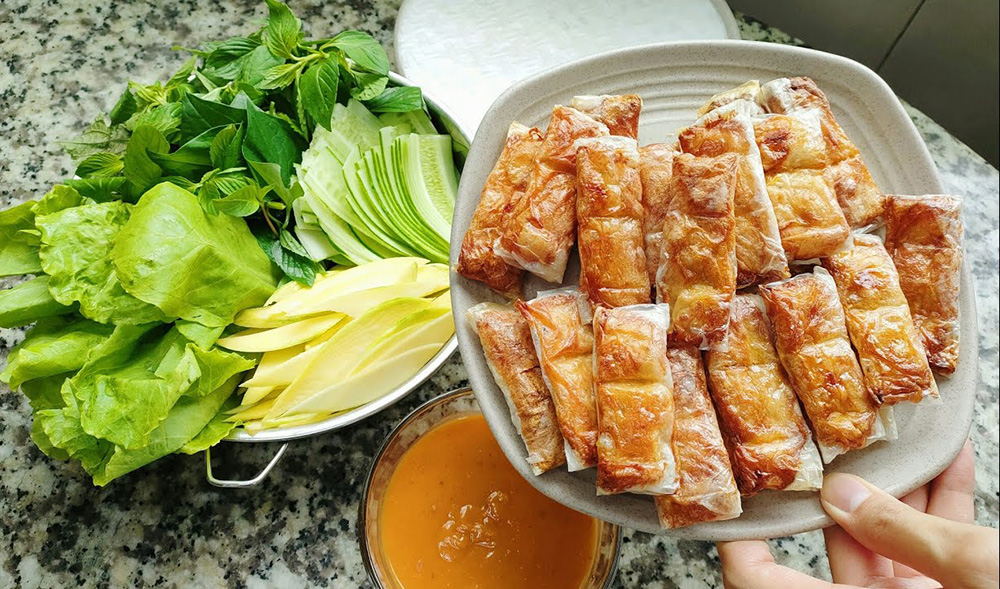
Among the simplest yet flavorful options in the street food landscape is Mam Ruoc Rice Paper. This delicacy showcases the bold flavors of mam ruoc, a fermented shrimp paste, paired with fresh vegetables. Often served with rice paper, this snack embodies the remarkable tastes of Southern Vietnamese cuisine.
Mam ruoc rice paper typically involves spreading the pungent, savory shrimp paste over fresh rice paper, topped with crisp vegetables, herbs, and sometimes spicy chilies to create a delightful contrast of flavors. It is a true representation of Vietnamese innovation, taking humble ingredients and transforming them into a tantalizing treat.
This dish not only highlights the region’s love for local produce but also serves as a fantastic introduction to the world of Vietnamese snacks. With its unique touch of creativity, Mam Ruoc Rice Paper can often be found alongside other street food offerings, reflecting the community's strong food culture.
To wrap up the exploration of Mui Ne's street food offerings, one must not overlook the delightful Re Cake, a sweet treat that satisfies the cravings of those with a penchant for dessert. These small, soft cakes are typically made with rice flour, sugar, and coconut milk, resulting in a delicate and subtly sweet flavor that resonates well with both locals and visitors.
Re Cake is often steamed, producing a soft and slightly chewy texture. This treat is distinctive in its presentation, often enjoyed as a snack or dessert during festivities and family gatherings. The vibrant colors and enticing aroma of Re Cake make it an irresistible addition to every culinary adventure.
In the world of street food, Re Cake serves as a reminder of the importance of sweets in Vietnamese culture, where desserts often embody tradition, connection, and shared enjoyment. People come together to enjoy these sweet delights, forging bonds over cherished flavors.
The culinary richness of Mui Ne is underpinned by a collection of key ingredients that uniquely characterize the region’s signature dishes. These components offer depth and authenticity while showcasing the vibrant flavors and cultural influences that define local cuisine.
At the core of Mui Ne’s culinary identity lies an abundance of fresh seafood. The coastal town’s proximity to the ocean guarantees a steady supply of fish, shellfish, and crustaceans, which play a pivotal role in creating delicious dishes. Each seafood offering resonates with the essence of coastal living and reflects the dedication of local fishermen who ensure that the catch is fresh and flavorful.
Many classic dishes, such as Tha Hotpot and Mai Fish Salad, highlight the deep connection between fresh seafood and local cuisine. Without the availability of quality ingredients, the richness of flavors that characterize Mui Ne’s dishes would be impossible to achieve.
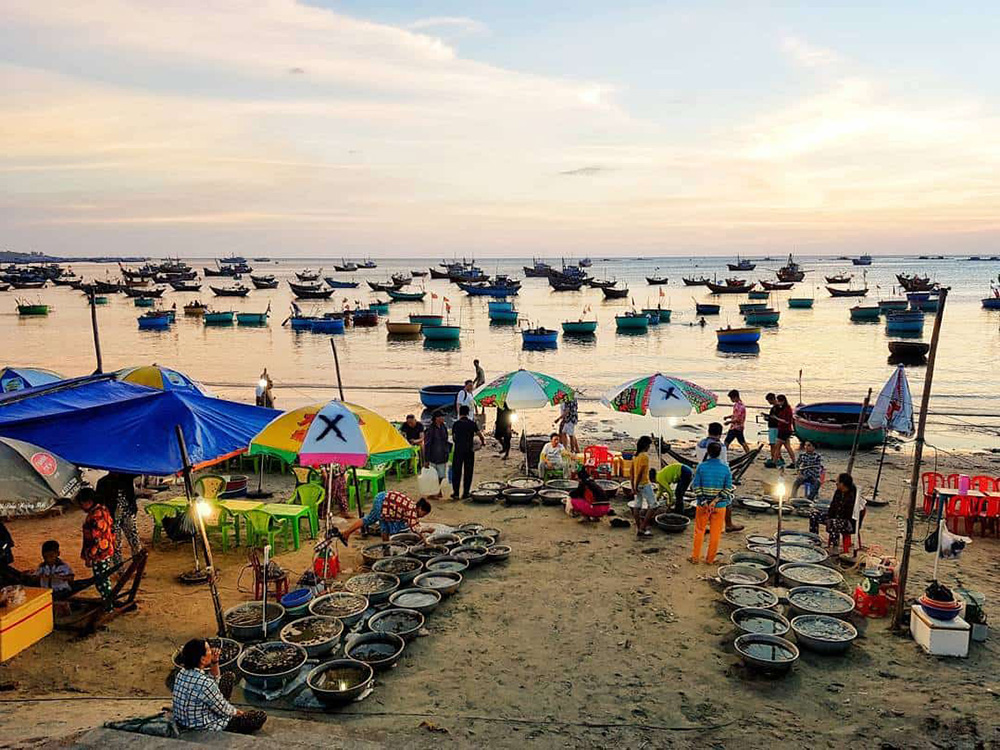
Another fundamental ingredient that epitomizes Mui Ne’s culinary landscape is fish sauce. Known for its umami-rich flavor, this condiment is crafted from fermented fish, typically anchovies, and has become a staple in Vietnamese cooking.
In Mui Ne, fish sauce is not merely a seasoning; it is integral to enhancing flavors across a variety of dishes. Whether used in marinades, salad dressings, or dipping sauces, its distinctive saltiness and complexity elevate every culinary creation. Dishes such as grilled seafood and fresh salads become memorable experiences thanks in large part to this essential component.
Local spices and herbs also play an essential role in achieving the authenticity of Mui Ne cuisine. Widely used herbs such as mint, cilantro, and basil add brightness and depth to dishes, while spices like garlic, chili, and ginger impart aromatic qualities that accentuate the flavors. The combination of fresh, local herbs strengthens the identity of each dish, making it unmistakably Vietnamese.
The incorporation of these signature ingredients into the region's culinary fabric not only captures the essence of Mai fish salad or Banh Xeo but also invites diners to connect with the cultural narrative of Mui Ne’s food traditions.
Mui Ne serves as a culinary haven for food lovers, showcasing a treasure trove of seafood specialties and traditional dishes steeped in local culture. From the interactive experience of Tha Hotpot to the tantalizing flavors of grilled seafood, the local cuisine invites visitors to embark on a culinary journey of discovery. Each dish tells a story, reflecting the region’s commitment to fresh ingredients, traditional cooking methods, and the joy of communal dining. Exploring the flavors of Mui Ne not only tantalizes the taste buds but also deepens the appreciation for the rich cultural heritage woven into each meal. Whether indulging in street food favorites or savoring traditional dishes, the culinary offerings in Mui Ne promise an unforgettable experience that highlights the beauty of Vietnamese gastronomy.